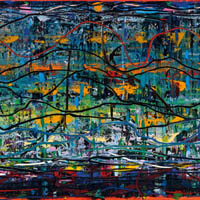Michael Johnson

Michael Johnsons paintings depict the process of managing colour- observing its nature and exploring its depths; examining the place where areas of colour meet: The edge is where the colours meet, not where the shapes change the shape is the container for the colour. Im interested in the life of colours: my painting has got more to do with that than form or tone or drawing.1 Johnson came to the attention of collectors and critics for the hard-edged abstract painting referred to in this statement but it was the intellectual program and the depth of engagement with issues of perception, vision, and psychology that motivated him.
A few years later, the process had driven the evolution of his work away from the concrete to the ephemeral, in contradiction to his earlier work. Whether it was this contrast or the process, his paintings found an immediate response. The intentions that had driven his work, the desire to create in his painting a place that does not exist,2 applied equally, however. He creates this place by confronting the viewer with physically dense surfaces teetering on the verge of a phantom dimension,3 thereby opening the painting up to endless interpretation.
Johnson was born in Sydney in 1938 and studied at the National Art School during the 1950s before moving to London where he lived and worked from 1961-66, initially to continue his studies and then to teach. He became a lecturer before returning to Australia in 1967 where he became the leader of a new generation of Abstractionists as exemplified in the exhibition, The Field, held at the National Gallery of Victoria in 1968, before moving to New York. The paintings he produced at this time were characteristic of international avant-garde painting. They are rigorous proclamations of the moral and aesthetic concerns of the period.
In his later work, it is as if the worthiness of these considerations fell away. Johnsons revised aesthetic, an evolution, resulted in a more organic expression of similar principles. The resulting paintings, less complex and more direct, which emerged in the early 1980s, rejected several fundamentals of the earlier work: geometric exactness, in favour of the uneven, fluid, and indistinct, making a virtue of the less substantial. Deep, rich colour was still Johnsons mtier, but paint was now layered in broken lines, overlaid with skeins of contrasting colour set in rhythmic waves across extensive panoramic canvases. Earth Line is a particularly fine and beautiful example of this style.
Johnson enjoyed considerable success with the new work and in 1988 Johnson was included in The Biennale of Sydney curated by the Art Gallery of New South Wales. By the time of the major survey of his work held in 1968-1989, he had become one of the most in-demand artists in Australia and arguably the most important abstract Australian artist of the time.
Footnotes:
1. Artists statement quoted in Lindsay, R., The Seventies: Australian Paintings, Tapestries from the Collection of National Australia Bank, The National Bank of Australasia Limited, Melbourne 1982, p.62
2. Michael Johnson, quoted in Maloon, T., From the Southern Cross: A View of World Art c.1940-88, The Biennale of Sydney in association with the Australian Broadcasting Corporation, Sydney, 1988, p.160
3. Maloon, T., op. cit.
Tim Abdallah